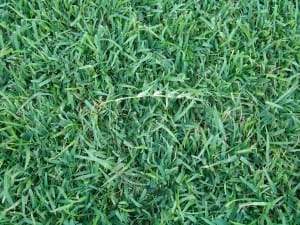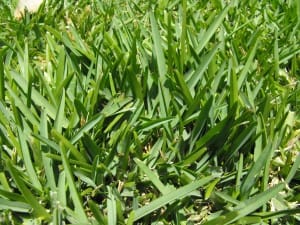Source(s): Gil Landry, PhD., Coordinator – UGA Center for Urban Agriculture, The University of Georgia.
Perhaps the most important factor in developing and maintaining an attractive and problem-free lawn is to choose a grass that is adapted to your area and has the qualities you desire. Centipedegrass and St. Augustinegrass are grown primarily in central, south, and coastal areas of Georgia.
Centipede
Centipede Grass(Eremochloa ophiuroides). This is a low, medium textured, slow growing but aggressive grass that can produce a dense, attractive, weed-free turf. It is more shade tolerant than bermudagrass but less shade tolerant than St. Augustine and zoysiagrass. Since centipede produces only surface runners, it is easily controlled around borders of flower beds and walks. It is well adapted as far north as Atlanta and Athens.
Centipede is the ideal grass for the homeowner who wants a fairly attractive lawn that needs little care. Centipede does not require much fertilizer or mowing, and compared to other lawn grasses, is generally resistant to most insects and diseases. It will, however, respond to good management and provide a very attractive turf. Centipede can be established from either seeds or sprigs. Since it is slow growing, it takes longer than bermuda and St. Augustine to completely cover.
Centipede is subject to “decline” problems that can be prevented by proper management. This includes care not to over fertilize, prevention of thatch accumulation, irrigation during drought stress, particularly in the fall, and maintaining a mowing height of 1-1 1/2 inches. Centipede is well adapted to soils of low fertility with a pH of 5.0 to 6.0 but grows best — like most grasses — at a soil pH of 6.0 to 6.5. For additional information see Cooperative Extension Service Leaflets No. 313, Centipede Lawns, and No. 177, Prevent Centipede Decline.
St. Augustine
St. Augustinegrass(Stenotaphrum secundatum). Compared to finer textured grasses like the bermudas, St. Augustine has large flat stems and broad coarse leaves. It has an attractive blue-green color and forms a deep, fairly dense turf. It spreads by long above-ground runners or stolons. While it is aggressive, it is easily controlled around borders. It produces only a few viable seed and is commonly planted by vegetative means.
St. Augustine is the most shade tolerant warm-season grass in Georgia. It is very susceptible to winter injury and should only be planted with caution as far north as Atlanta and Athens. Perhaps the greatest disadvantage of this grass is its sensitivity to the chinch bug. While insecticides can control this insect, frequent applications are required.
The more common St. Augustinegrass varieties are Bitter Blue, Floratine and Floratam. Bitter Blue has the best shade tolerance but is sensitive to chinch bugs and St. Augustine Decline Virus (SADV). Floratine has the finest leaf texture but is also susceptible to chinch bugs and SADV. Floratam has the coarsest leaf texture, is resistant to chinch bug and SADV, but is not as shade tolerant as the others.
Resource(s): Lawns in Georgia
Center Publication Number: 126
- Grasscycling: Feed Your Landscape, Not the Landfill - September 24, 2013
- Fertilizing Lawns - September 24, 2013
- Mowing Lawns - September 24, 2013


I have centipede grass in my yard now but I want St. Aug. I find the Centipede is a weak grass, not as full as St. Aug. I can see the ground right thru the grass in a lot of different spots in my yard. If I throw St. Aug. seed in different spots of my yard, will the St. Aug take over the centipede? I live in Marrero, about 10-20 miles south of New Orleans, La. Thanks for your time,
D. Landry.
What is the difference in cost between the two?